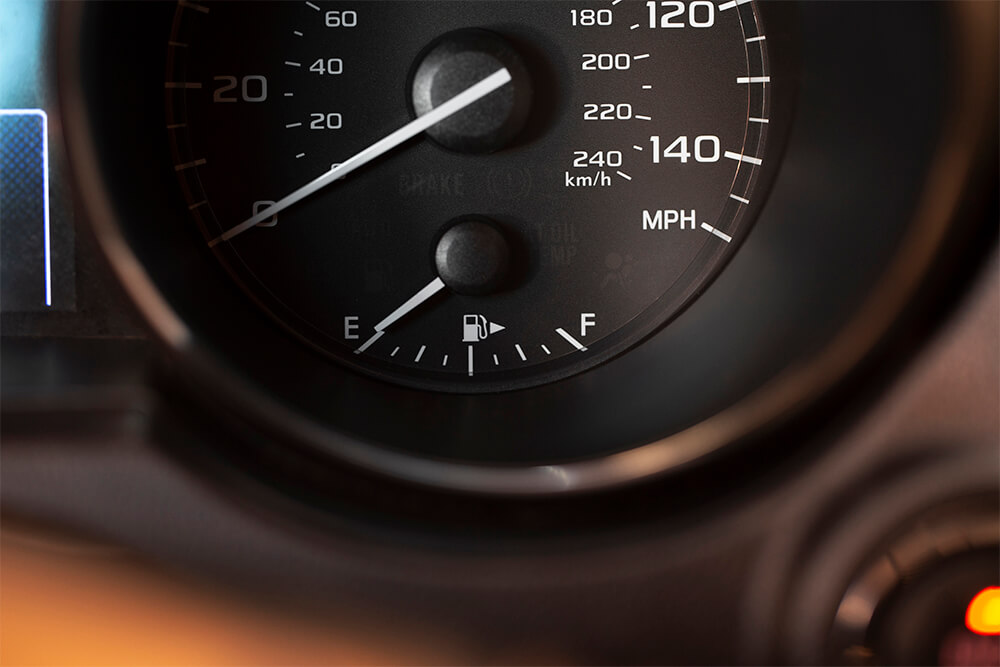TIRE TIPS

HOW TO IMPROVE YOUR VEHICLE'S FUEL EFFICIENCY
Reducing driving time is the most obvious solution to improving your vehicle’s fuel efficiency. Carpooling and using public transportation are the more obvious choices that have the greatest effect on cutting back fuel costs.
Your driving habits, vehicle type, and model also significantly impact your fuel economy by up to 15-30% at highway speeds. This segment highlights the most efficient ways to improve your vehicle’s fuel efficiency. Follow these steps to reduce fuel economy today.
Slow Down
An interesting fact about gas mileage efficiency is that it tends to decrease at speeds above 50 miles per hour. Many automakers design each vehicle model to have optimal fuel efficiency speeds. Speeding can significantly reduce fuel economy. However, driving at slower speeds has been known to improve fuel savings by up to 51 cents per gallon, depending on the driving conditions and vehicle model.
Turn off the Car
While idling gets zero miles per gallon (MPG), it collectively consumes many billion gallons of gas per year. As such, it’s always a good idea to turn off your car, especially if the expected wait time is longer than 10 seconds.
Idling cars consume even more fuel if they have air conditioning. Turning off the vehicle can save you up to 4 cents on gas per minute.
Use Cruise Control (When Appropriate)
Activating cruise control is one of the most effective ways to improve fuel economy. However, it may not be appropriate in all conditions. For instance, cruise control may not be the best fuel-economical option on hilly terrain.
However, sticking to the required speed limit using cruise control on even roads and avoiding rapid acceleration can improve fuel efficiency by up to 14%, depending on the vehicle model.
Replace Spark Plugs
Bad spark plugs can reduce your car’s fuel economy by up to 30%, costing most drivers about 94 cents per gallon in today’s gas prices. If your car’s gas mileage drops suddenly, there’s a good chance the main reason is misfiring spark plugs.
We recommend having a professional auto expert check the condition of the current spark plugs and replace faulty ones. You may also want to check your owner’s manual, which usually indicates the best scheduled times for spark plugs.
Check the Tire Pressure
Did you know that over 1.25 billion gallons of fuel are wasted on underinflated tires annually? That’s about 1% of the total fuel consumption. Tires can lose up to 2 psi per month. And each tire that’s underinflated by 10 psi can reduce fuel economy by up to 3.3%.
If all your tires are underinflated by 10 psi, they would substantially reduce your vehicle’s fuel economy, equating to 31 cents more per gallon of fuel.
The TreadNation Program also offers clients in Canada free tire rotation, allowing customers to buy tires at cost and tire storage. Visit TreadNation for great tire tips and more tips on fuel efficiency.
In Sum
While reducing the amount of driving we do is the best way to use less fuel, especially with today’s rising fuel prices, you can take other proactive steps to improve your car’s fuel efficiency. Changing your gas-guzzling habits and maintaining a regular maintenance schedule are the best ways to keep your vehicle in excellent condition and fuel economy low.
Contact us for more information on how to improve your vehicle’s efficiency and essential car maintenance checklist.

